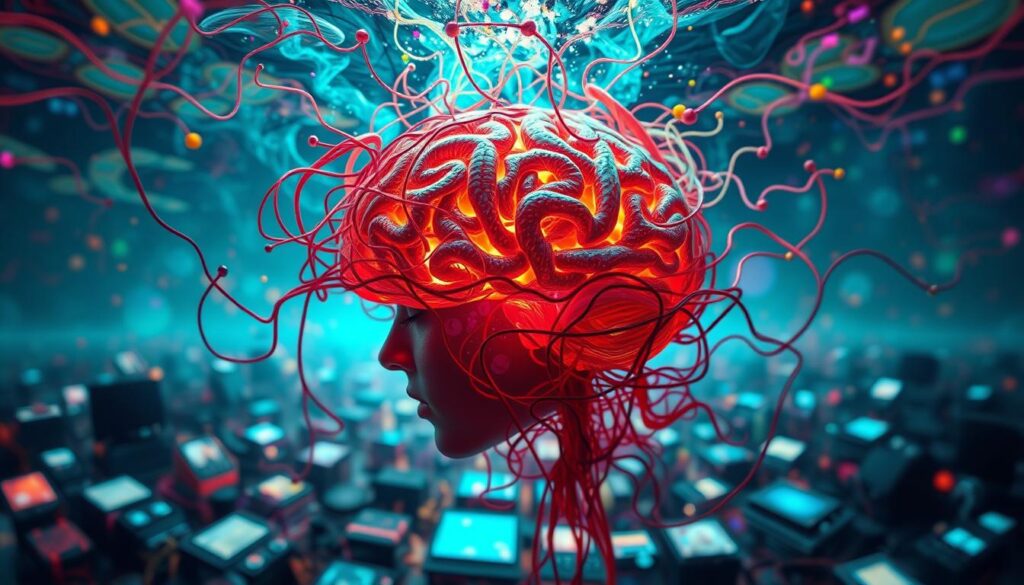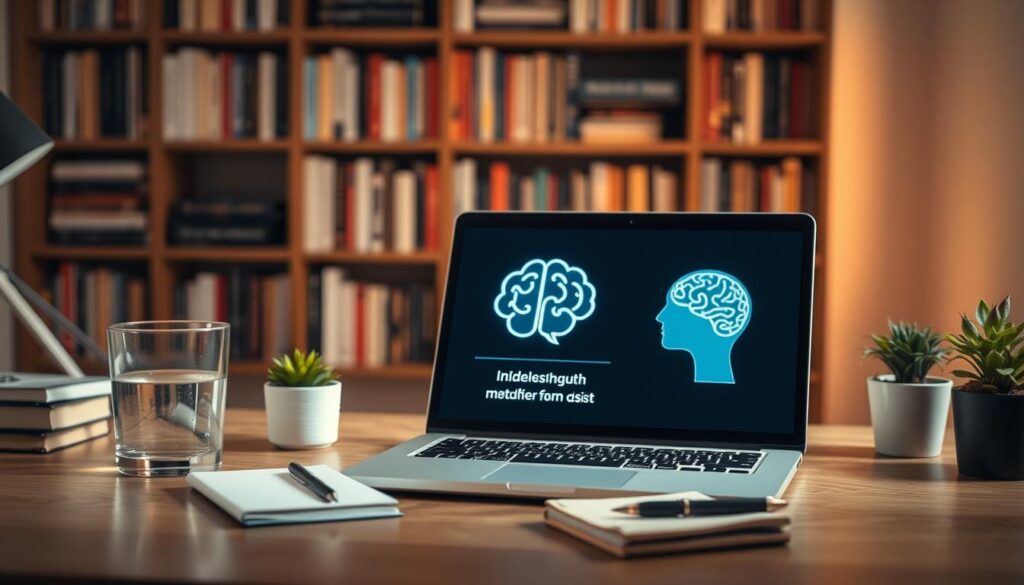Did you know that taking just seven days off social media can make you feel much better than scrolling online for the same time1? The term “brainrot” is now used to describe the harm from too much social media2. As we spend more time staring at screens, it’s vital to find a balance between digital fun and our mental health.
More people are talking about brainrot, showing they’re worried about its effects2. It’s important to understand brainrot to lessen its harm. Too much screen time can make us feel slow, tired, and less focused1. Young adults, in particular, struggle with social media addiction, which hurts their ability to plan and make decisions1. It’s clear we need to mix entertainment with activities that keep our minds sharp.
Key Takeaways
- Social media consumption can significantly influence mental well-being, particularlly in young adults.
- Excessive screen time is associated with cognitive decline and reduced attention span.
- Taking breaks from social media can dramatically improve mental health.
- Awareness of brainrot has increased, highlighting the need for mindful digital consumption.
- Balancing mindless entertainment with mental stimulation is critical for cognitive health.
Understanding the Brainrot Phenomenon
Brainrot is a growing concern, linked to too much digital use. It causes mental fog, tiredness, and trouble focusing. This is common among younger people, born in the 2010s and later, who have always known the digital world34.
Too much screen time and digital overload are big reasons for brainrot. Sites like TikTok, with its addictive content, are part of the problem. For example, “Skibidi Toilet” got over 164 million views, showing how engaging such content can be34. Doctors, like those from the Irish Medical Organisation, urge action to protect young minds from social media harm4.
Definition and Symptoms
Brainrot is more than just a term; it’s a serious issue caused by too much digital content. People with brainrot find it hard to solve problems and make decisions. They often feel tired and have trouble focusing, a common problem among digital media users3.
Brainrot also brings anxiety and stress, made worse by constant bad news online. These symptoms are a big concern for many.
Causes and Contributing Factors
Many things lead to brainrot, but too much screen time and digital overload are key. Social media’s algorithms make it worse by showing more ‘brainrot’ content5. Short videos on TikTok and Instagram Reels are very popular, adding to the problem35.
Memes and viral content also play a big role, showing how digital media affects our minds4.
Doctors, including those at the United States Surgeon General’s office, want warning labels on social media. They say these platforms are addictive and harm our mental health. This can lead to lasting damage to our brains and minds45.
The Cognitive Impacts of Excessive Screen Time
Too much screen time affects our brains in big ways. It can lead to memory loss and make it harder to focus. These problems happen to people of all ages.
Cognitive Decline and Brain Fog
Long hours in front of screens can make our brains foggy. This makes it hard to think clearly and solve problems. It’s like our brains are getting “rotten.”
In 2024, “brain rot” was named the Oxford Word of the Year6. Young people are hit the hardest by digital addiction6. Today, 20% of adults spend over 40 hours a week online7.
The term “brain rot” has been around for nearly 200 years8. But it’s just as relevant today. It’s caused by too much screen time. For example, too much digital media can hurt our memory and change our brains7.
Dr. Sanjay Gupta says doing mental exercises can help fight brain decline from screens6.
Memory Loss and Attention Span Reduction
Too much screen time also leads to memory loss and shorter attention spans. People spend 5 to 8 hours a day on social media, which can harm their brains8. This can make them age faster and forget things more easily8.
Generation Z, in particular, is overwhelmed by digital content. This makes them focus less and prefer screens over people6.
Children who watch a lot of screens at a young age have brain problems. These problems affect their language skills and understanding7. Also, using digital media while multitasking can lead to ADHD7.
These findings show we need to find ways to keep our brains sharp. Mindfulness and less screen time are good places to start.
The Role of Social Media in Mental Deterioration
In today’s digital world, sites like Instagram, Twitter, TikTok, and Facebook keep us hooked. They offer endless content, leading to bad habits and mental decline. The term “brain rot” is now a big worry, named the 2024 Word of the Year by Oxford University Press9. It shows how worried we are about its effects on our minds10.
The term “brain rot” has seen a huge jump, up by 230% from 2023 to 202410. This shows it’s a big problem we face today.
Doomscrolling and Zombie Scrolling
Doomscrolling and zombie scrolling are bad habits that harm our mental health. They make us scroll endlessly through stuff that’s not good for us. This can make us feel tired and lose interest in things we used to enjoy9.
It also makes it hard to focus on hard tasks. This is because constant notifications mess with our motivation and attention9.
Social Media Addiction
Social media addiction is like a physical addiction. It takes over our lives, making us prefer screens to real people. This can lead to feeling lonely and having weak relationships9.
It can also make us feel moody, restless, and even increase the chance of depression9. The rise of “brain rot” among young people shows a big shift in how we use social media10. It’s a sign of a major moment for our mental health and online habits9.
Long-term addiction can make our thinking and decision-making worse9. It’s key to recognize and change these habits to protect our mental well-being.
Brainrot and Emotional Health
The term ‘brainrot’ refers to the harm caused by too much digital media on our emotional health. It’s linked to more anxiety and depression in people who spend a lot of time on screens. Digital platforms make us compare ourselves to others, leading to feelings of not being good enough. This can make us feel anxious and depressed11.
Brainrot also makes us prefer talking online over talking face-to-face. This can make us feel lonely and isolated11.
Anxiety and Depression
There’s a clear connection between too much digital time and feeling down. People with brainrot often feel restless, empty, and tired. These feelings can lead to depression11.
This is a big problem for teenagers. Their brains are more likely to get hooked on social media. About 25% of teens struggle with digital media addiction12.
Irritability and Stress
Digital distractions and the need to do many things at once can really stress us out. It makes us feel overwhelmed and can’t stop procrastinating. This stress is bad for our mental health11.
It’s important to control our screen time and focus on our mental health. Too much stimulation can harm our brain’s ability to learn and change11. Finding ways to reduce stress is key to feeling better and being emotionally healthy.
Cognitive Decline Prevention Strategies
To prevent cognitive decline, we need to make healthy digital habits and do mental exercises. By using different strategies, we can keep our brains healthy and avoid the bad effects of too much screen time.
Limiting Screen Time
One important step is to limit screen time. We can do this by using apps to track and control our screen use. Making tech-free zones in our homes and setting digital time limits can also help.
Also, having regular screen-free times helps keep a balance in our digital use.
Engaging in Mentally Stimulating Activities
Doing activities that challenge our minds, like reading, solving puzzles, or learning new things, boosts our brain health. Physical activities, like tai chi, can also improve our brain function and increase brain size13.
Getting enough sleep, 7 to 9 hours a night, is also key for a healthy brain13. Studies show that making positive lifestyle changes helps prevent mental health decline and keeps our brains strong14.
The World Health Organization says brain health is about being physically, mentally, and socially well. This includes learning, memory, problem-solving, and making decisions15. A varied “mental diet” with positive digital content helps keep our brains healthy.
The Importance of a Balanced “Mental Diet”
In today’s digital age, it’s key to keep our mental diet balanced for well-being. We need to pick our digital content wisely. This means mixing positive media and educational resources. Doing so makes our online time more enriching and mentally stimulating.
Diversifying Digital Content
Diversifying digital content is essential for a healthy mental diet. It’s about balancing fun with content that boosts creativity, learning, and positive feelings. For instance, instead of endless social media scrolling, try podcasts, educational videos, or learning apps.
Studies show we spend over two hours daily on social media16. Adding variety can prevent mental fatigue and help us focus better16
Incorporating Positive and Educational Media
It’s also important to include positive media and educational resources in our mental diet. Positive media can lift our mood and well-being. Educational resources keep our minds sharp and engaged.
Reports show big benefits in thinking and emotional health from educational media. This is important because our attention span has dropped from 12 seconds in 2000 to 8 seconds in 2013, thanks to digital tech16. Adding educational content to our daily lives helps fight forgetfulness and focus problems linked to too much screen time16.
Tools for Managing Screen Time and Enhancing Focus
With the rise in “brain rot” and its effects on cognitive health, managing screen time and focus is key. Digital planners and mindfulness apps help reduce stress from too much screen time.
Top Digital Planners for Organizing Tasks
Digital planners are essential for organizing tasks well. They offer structured schedules and reminders to fight procrastination and boost productivity. Here are some top digital planners:
- Todoist: Known for its simplicity, Todoist lets users make task lists and set priorities. This can greatly improve focus and lower stress.
- Trello: Trello’s visual boards are great for managing projects and working together. They’re perfect for teams where everyone needs to watch their screen time.
- Notion: A versatile planner that combines notes, tasks, databases, and calendars. It’s a strong tool for managing tasks fully.
Mindfulness Apps for Reducing Stress
Mindfulness apps offer exercises to fight digital overload and boost mental clarity. They’re key in managing screen time by providing guided meditation and relaxation:
- Headspace: This app has guided meditations and mindfulness practices. It helps users relax and focus better.
- Calm: Known for its calming soundtracks and sleep stories, Calm helps reduce stress and improve mental health.
- Insight Timer: With a huge library of free meditations and mindfulness practices, Insight Timer supports lasting mental calm and focus.
The rise of “brain rot” shows the need for digital detoxes and good screen time management17. These tools help lessen the bad effects of too much screen time. They improve focus and mental health.
Balancing Mindless Entertainment and Brain Health
In today’s digital world, it’s key to find a balance between fun and brain health. Too much time on screens can make our minds dull and less focused18. We need to set limits and choose to interact more with the real world.
Setting Boundaries and Prioritizing Real-World Interaction
It’s important to control how much time we spend on digital devices. Using tools to manage our screen time helps avoid the negative effects of too much digital use. By setting strict times for screen activities, we can do more things that are good for our brains18.
Doing things like reading, playing music, or solving puzzles can help. These activities make our brains stronger and better at solving problems18. Practicing mindfulness also helps us focus better and feel less stressed. Apps can help us stay mindful18.
Choosing to spend time with people face-to-face is also key. Too much screen time can hurt our relationships, making us feel lonely and sad18. So, it’s important to plan regular times to meet up with friends and family18.
It’s also good to use digital content that’s enriching. Watching documentaries or listening to podcasts can make our screen time valuable for our brains. Governments and groups are working to help us stay mentally healthy, but we need more data on how well they’re doing19.
In short, finding a balance means setting limits and choosing to interact more with the world around us. This way, we can enjoy digital media without harming our mental health.
Conclusion
In today’s digital world, it’s vital to control how much we use digital media. Too much of the wrong kind can harm our minds and feelings. It can make us less sharp, less able to talk well, and less productive2021.
Young people, in particular, are struggling with this. Over 60% of Gen Z says social media slang has hurt their talking skills. And 50% feel they don’t understand complex topics as well because of short videos2022.
Reducing screen time and choosing better digital content can help our brains stay sharp. Exercise and activities that challenge our minds can make our brains more flexible and adaptable21. A diet of positive and educational media can also counteract the negative effects of too much screen time2122.
By being more mindful of what we watch and do online, we can protect our mental health. Let’s focus on making choices that improve our mental health and overall well-being.
FAQ
What is brainrot and what are its symptoms?
What causes brainrot?
How does cognitive decline and brain fog relate to screen time?
How does digital consumption affect memory loss and attention span?
What are doomscrolling and zombie scrolling?
What is the impact of social media addiction on mental health?
How does extended digital engagement contribute to anxiety and depression?
Why do constant digital interruptions lead to irritability and stress?
What strategies can help limit screen time?
What are some activities that can help prevent cognitive decline?
How can I diversify my digital content?
Why should I incorporate positive and educational media into my routine?
Which digital planners are best for organizing tasks?
What are the top mindfulness apps for reducing stress?
How can I balance mindless entertainment with maintaining brain health?
Source Links
- Brain Rot: The Impact on Young Adult Mental Health – https://www.newportinstitute.com/resources/co-occurring-disorders/brain-rot/
- Generative AI And Brain Rot – https://www.forbes.com/sites/lanceeliot/2024/06/18/generative-ai-and-brain-rot/
- Why teenagers are deliberately seeking brain rot on TikTok | Psyche Ideas – https://psyche.co/ideas/why-teenagers-are-deliberately-seeking-brain-rot-on-tiktok
- Brainrot: Understanding Meme Culture and Digital Obsession Among Gen Alpha – https://www.thinkhousehq.com/the-youth-lab/uhhh-brainrot
- Brainrot explained: Adapting to the new online affliction – https://medium.com/design-bootcamp/brainrot-explained-adapting-to-the-new-online-affliction-468fa33ac514
- What Is Brain Rot? It’s Far More Common Than You Might Think – https://makeheadway.com/blog/what-is-brain-rot/
- The impact of the digital revolution on human brain and behavior: where do we stand? – https://pmc.ncbi.nlm.nih.gov/articles/PMC7366944/
- Brain Rot: Are Our Smartphones Making Us Stupid? | Premier Health – https://www.premierhealth.com/your-health/articles/healthnow/brain-rot–are-our-smartphones-making-us-stupid
- How Brain Rot Impacts Your Mental Health – https://www.psychologs.com/how-brain-rot-impacts-your-mental-health/?srsltid=AfmBOorVY74xNIF5Uzj36hG9GcONtC2qgV8A49WIFQoqjwTnGEkp5ZNQ
- What is brain rot, the Oxford University Press 2024 word of the year? – https://www.bbc.com/news/articles/cx2n2r695nzo
- How Brain Rot Impacts Your Mental Health – https://www.psychologs.com/how-brain-rot-impacts-your-mental-health/?srsltid=AfmBOopY2Pn_1vl7IkoVoQ87kMri2iwzAlmvqt3Nyh_GMAjWubWjnnj0
- Why ‘Brain Rot’ Can Hurt Learning — and How One District Is Kicking It Out of School – EdSurge News – https://www.edsurge.com/news/2025-01-16-why-brain-rot-can-hurt-learning-and-how-one-district-is-kicking-it-out-of-school
- Neuroplasticity: What Is Its Role in Cognitive Health? – https://www.everydayhealth.com/brain-health/neuroplasticity-what-is-its-role-in-cognitive-health/
- Social Psychiatric New Years Resolution #4: Preventing Rotting Brains – https://www.psychiatrictimes.com/view/social-psychiatric-new-years-resolution-4-preventing-rotting-brains
- Brain Rot: Why Brain Health Matters Now More Than Ever – https://www.psychologytoday.com/us/blog/brain-care-for-all/202412/brain-rot-why-brain-health-matters-now-more-than-ever
- Brain Rot Explained: Practical Tips to Restore Mental Clarity – https://affine.pro/blog/brain-rot
- The Negative Impact of Brain Rot on Your Results at Work – https://cake.com/empowered-team/brain-rot-hinders-productivity-performance/
- Brain Rot: Is your screen time killing your brain? The shocking truth about brain rot | – Times of India – https://timesofindia.indiatimes.com/life-style/health-fitness/health-news/is-your-screen-time-killing-your-brain-the-shocking-truth-about-brain-rot/articleshow/116197507.cms
- Brain Rot: The Mental Geography of Digital Consumption – https://medium.com/@ayhanbzkrt/brain-rot-the-mental-geography-of-digital-consumption-72d825dc4569
- We are cooked: ‘Brain rot’ has gone too far – The Tufts Daily – https://www.tuftsdaily.com/article/2024/10/we-are-cooked-brain-rot-has-gone-too-far
- How Brain Rot Impacts Your Mental Health – https://www.psychologs.com/how-brain-rot-impacts-your-mental-health/?srsltid=AfmBOopfRCGs2aCJQ_NWVF3tbqP74yvW8Qh2B26MSE9xJ5n_QdddF4Dx
- Brain Rot: Endemic Amongst Students – https://theebbtide.com/features/brain-rot-endemic-amongst-students/05/2024/






